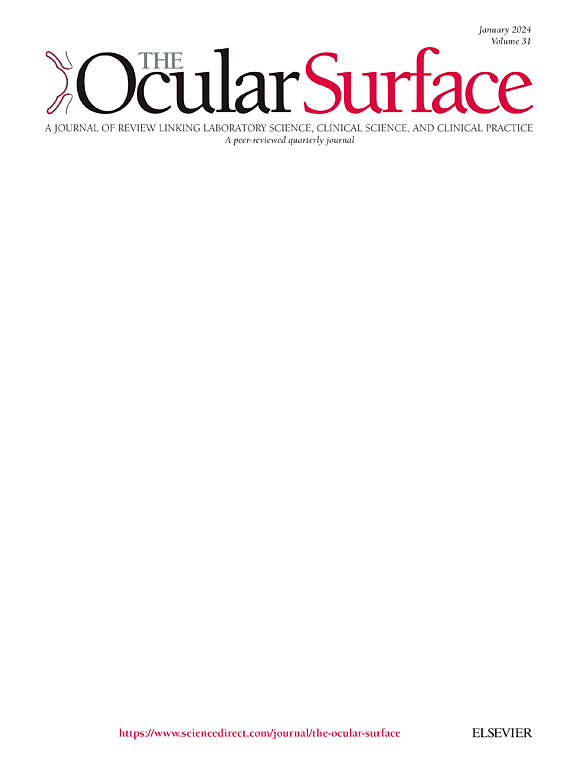在小鼠移植物抗宿主病模型中矿质皮质激素受体的表达和矿质皮质激素受体拮抗剂螺内酯的作用。
IF 5.9
1区 医学
Q1 OPHTHALMOLOGY
引用次数: 0
摘要
目的:局部使用螺内酯(一种矿物质皮质激素受体拮抗剂(MRA))可改善眼部移植物抗宿主病(GVHD)患者的干眼症状,但其具体机制仍不清楚。本研究旨在利用慢性移植物抗宿主病(cGVHD)小鼠模型研究螺内酯眼药水对眼表的影响,并确定矿皮质激素受体(MR)的表达:方法:通过将 B10.D2 小鼠的异体骨髓移植(BMT)至 BALB/c 小鼠,建立了 cGVHD 小鼠模型。随后,用 0.005% 螺内酯或载体眼药水治疗 cGVHD 小鼠。在 BMT 术后每隔 4 周对两组受者的眼睑、角膜和结膜进行分析:结果:使用螺内酯眼药水治疗的 cGVHD 小鼠的眼部 GVHD 症状,如角膜上皮损伤、睑板腺枯竭和眼表面炎性细胞浸润,均明显减少。cGVHD 小鼠角膜和结膜上皮中 MR NR3C2 的表达明显增加。HSP47+NR3C2+MR表达的成纤维细胞、CD45+NR3C2+MR表达的白细胞和CD4+NR3C2+MR表达的T细胞浸润cGVHD小鼠眼表组织的程度明显高于合成对照组:结论:在小鼠 cGVHD 模型中,上皮细胞、成纤维细胞和 T 细胞中的 MR 表达增加,而 MRA 和螺内酯眼药水可减轻眼部 GVHD 的严重程度。这些研究结果表明,在这种小鼠模型中,MR 信号传导部分导致了眼部 GVHD 的发生。本文章由计算机程序翻译,如有差异,请以英文原文为准。
Mineralocorticoid receptor expression and the effects of the mineralocorticoid receptor antagonist spironolactone in a murine model of graft-versus-host disease
Purpose
The topical administration of spironolactone, a mineralocorticoid receptor antagonist (MRA) improves dry eye symptoms in patients with ocular graft-versus-host disease (GVHD); however, the detailed mechanism remains unclear. This study aimed to investigate the effects of spironolactone eyedrops on the ocular surface using a chronic GVHD (cGVHD) mouse model and to determine the expression of the mineralocorticoid receptor (MR).
Methods
A cGVHD mouse model was established by allogeneic bone marrow transplantation (BMT) from B10.D2 mice to BALB/c mice. Subsequently, cGVHD mice were treated with either 0.005 % spironolactone or vehicle eyedrops. The eyelids, cornea and conjunctiva of the recipients were analyzed at 4-week intervals post-BMT in both groups.
Results
Signs of ocular GVHD, such as corneal epithelial damage, depletion of meibomian glands, and inflammatory cell infiltration onto the ocular surface, were significantly decreased in cGVHD mice treated with spironolactone eyedrops. The expression of the MR NR3C2 in the corneal and conjunctival epithelia was significantly increased in cGVHD mice. HSP47+NR3C2+ MR-expressing fibroblasts, CD45+NR3C2+ MR-expressing leukocytes, and CD4+NR3C2+ MR-expressing T cells infiltrated the ocular surface tissue of cGVHD mice significantly more than that of syngeneic controls.
Conclusions
MR expression is increased in epithelial cells, fibroblasts, and T cells in a murine cGVHD model, whereas MRA and spironolactone eyedrops could attenuate the severity of ocular GVHD. These findings suggest that MR signaling partially contributes to the development of ocular GVHD in this mouse model.
求助全文
通过发布文献求助,成功后即可免费获取论文全文。
去求助
来源期刊

Ocular Surface
医学-眼科学
CiteScore
11.60
自引率
14.10%
发文量
97
审稿时长
39 days
期刊介绍:
The Ocular Surface, a quarterly, a peer-reviewed journal, is an authoritative resource that integrates and interprets major findings in diverse fields related to the ocular surface, including ophthalmology, optometry, genetics, molecular biology, pharmacology, immunology, infectious disease, and epidemiology. Its critical review articles cover the most current knowledge on medical and surgical management of ocular surface pathology, new understandings of ocular surface physiology, the meaning of recent discoveries on how the ocular surface responds to injury and disease, and updates on drug and device development. The journal also publishes select original research reports and articles describing cutting-edge techniques and technology in the field.
Benefits to authors
We also provide many author benefits, such as free PDFs, a liberal copyright policy, special discounts on Elsevier publications and much more. Please click here for more information on our author services.
Please see our Guide for Authors for information on article submission. If you require any further information or help, please visit our Support Center
 求助内容:
求助内容: 应助结果提醒方式:
应助结果提醒方式:


